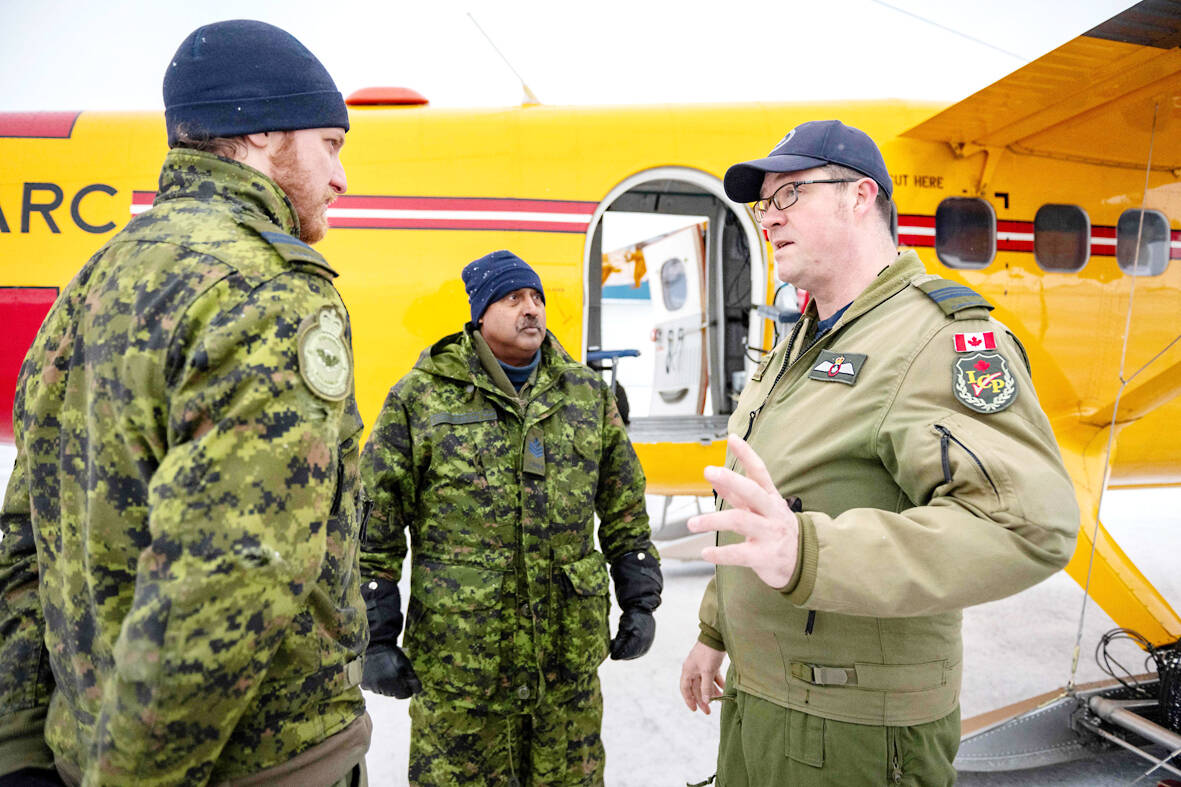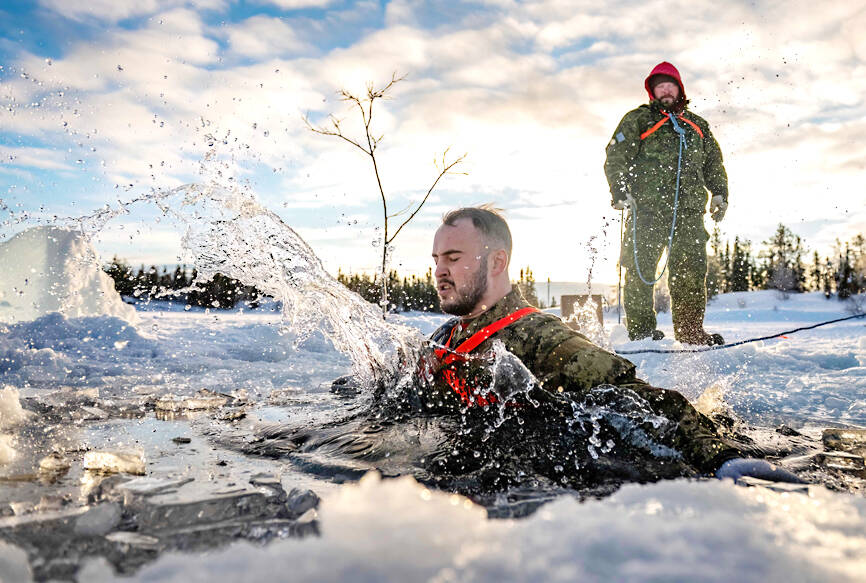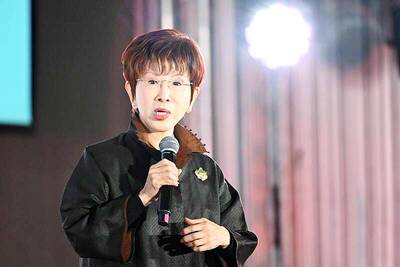In the mess hall of a Canadian military base a few hundred kilometers south of the Arctic Circle, Brigadier-General Daniel Riviere pointed to a map highlighting the region that is becoming a national priority.
“All eyes are on the Arctic today,” said Riviere, who heads the Canadian Armed Forces Joint Task Force North.
Thawing ice caused by climate change is opening up the Arctic and creating access to oil and gas resources, in addition to minerals and fish. That has created a new strategic reality for Canada, as nations with Arctic borders like the US and Russia intensify their focus on the region.

Photo: AFP
China, which is not an Arctic power, sees the area as “a new crossroads of the world,” the US warned in the final weeks of president Joe Biden’s administration. Ottawa has responded by announcing plans to reinforce its military and diplomatic presence in the Arctic, part of a broader effort to assert its sovereignty in a region that accounts for 40 percent of Canadian territory and 75 percent of its coastline.
Canada needs to act now because “the Northwest Passage will become a main artery of trade,” Riviere said, referring to the Arctic connection between the Atlantic and Pacific oceans.
Plans to bolster Canada’s Arctic presence include deploying new patrol ships, destroyers, icebreakers and submarines capable of operating under the ice cap, in addition to more planes and drones to monitor and defend territory.

Photo: AFP
‘ASSERT SOVEREIGNTY’
At the Joint Task Force North’s headquarters in Yellowknife, the capital of Canada’s Northwest Territories, huge hangars house planes capable of landing on frozen lakes.
There is equipment designed to filter salt water from ice floes, and tents made for temperatures of -50 degrees Celsius.
Moving military resources around the area is complex work that is carried out by Twin Otters, a strategic transport aircraft that can operate in rugged environments.
On the tarmac after a flight over vast expanses of snow, forests and frozen lakes, Major Marlon Mongeon, who pilots one of the aircrafts, said that part of the military’s job is “to assert sovereignty of our borders and land.”
Canada has only a handful of northern military bases. To monitor the north, it relies on Canadian Rangers, reservists stationed in remote areas throughout the Arctic, many of whom are from the country’s Indigenous communities.
They’re known as “the eyes and ears of the north,” and some say their numbers need boosting in order to meet Canada’s evolving challenges. The Rangers monitor more than 4 million square kilometers, relying on their traditional knowledge of survival in this inhospitable area combined with modern military techniques.
They have been patrolling the country’s farthest regions since the Cold War began in the late 1940s, when military officials realized the Arctic was a vulnerable access point.
‘MOST HOSTILE THREAT’
“Having people from the area who know the land and the hazards, especially in the barren lands up there, to help assist you to get somewhere is vital,” said Canadian Ranger Les Paulson.
Because the military can’t deploy full-time soldiers across the entire region, the Rangers offer a rapid response option in remote communities, including in the event of “a breach of sovereignty” or airplane or shipping accidents, explained Paul Skrypnyk, 40, who is also a Ranger.
Climate change has made the Northwest Passage increasingly accessible to ships for navigation during summer months. That promises to shorten voyages from Europe to Asia by one to two weeks, compared to the Suez Canal route. Increased traffic, including among cruise ships, has compelled Canada to boost its capacities in the region to respond to accidents or emergencies.
In Yellowknife, training is being stepped up to prepare for a range of significant events, including how to respond to a fall into icy waters. Among those training was Canadian Ranger Thomas Clarke.
Still soaked from his jump into a hole dug in the sea ice, Clarke said that in the Arctic, the environment remains the greatest danger. “Mother nature... is the most hostile threat,” he said. “Mother nature will try to end you, before anything else.”

Cheng Ching-hsiang (鄭青祥) turned a small triangle of concrete jammed between two old shops into a cool little bar called 9dimension. In front of the shop, a steampunk-like structure was welded by himself to serve as a booth where he prepares cocktails. “Yancheng used to be just old people,” he says, “but now young people are coming and creating the New Yancheng.” Around the corner, Yu Hsiu-jao (饒毓琇), opened Tiny Cafe. True to its name, it is the size of a cupboard and serves cold-brewed coffee. “Small shops are so special and have personality,” she says, “people come to Yancheng to find such treasures.” She

The low voter turnout for the referendum on Aug. 23 shows that many Taiwanese are apathetic about nuclear energy, but there are long-term energy stakes involved that the public needs to grasp Taiwan faces an energy trilemma: soaring AI-driven demand, pressure to cut carbon and reliance on fragile fuel imports. But the nuclear referendum on Aug. 23 showed how little this registered with voters, many of whom neither see the long game nor grasp the stakes. Volunteer referendum worker Vivian Chen (陳薇安) put it bluntly: “I’ve seen many people asking what they’re voting for when they arrive to vote. They cast their vote without even doing any research.” Imagine Taiwanese voters invited to a poker table. The bet looked simple — yes or no — yet most never showed. More than two-thirds of those

In July of 1995, a group of local DJs began posting an event flyer around Taipei. It was cheaply photocopied and nearly all in English, with a hand-drawn map on the back and, on the front, a big red hand print alongside one prominent line of text, “Finally… THE PARTY.” The map led to a remote floodplain in Taipei County (now New Taipei City) just across the Tamsui River from Taipei. The organizers got permission from no one. They just drove up in a blue Taiwanese pickup truck, set up a generator, two speakers, two turntables and a mixer. They

Former Chinese Nationalist Party (KMT) chairwoman Hung Hsiu-chu’s (洪秀柱) attendance at the Chinese Communist Party’s (CPP) “Chinese People’s War of Resistance Against Japanese Aggression and the World Anti-Fascist War” parade in Beijing is infuriating, embarrassing and insulting to nearly everyone in Taiwan, and Taiwan’s friends and allies. She is also ripping off bandages and pouring salt into old wounds. In the process she managed to tie both the KMT and the Democratic Progressive Party (DPP) into uncomfortable knots. The KMT continues to honor their heroic fighters, who defended China against the invading Japanese Empire, which inflicted unimaginable horrors on the